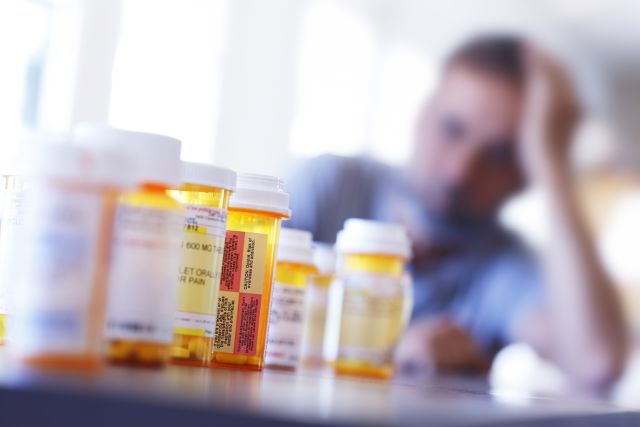Updated on February 16, 2024.
Opioids are a class of drugs used to reduce or eliminate pain in the body. They also carry a number of serious risks and side effects. Perhaps most significantly, opioids can cause changes in brain and body chemistry that lead to misuse, dependence, and even addiction.
Here’s what to know about the downsides of these powerful drugs, and how to guard against them.
How opioids work
Opioids include oxycodone, hydrocodone, and codeine, as well as heroin, morphine, and fentanyl. When you take an opioid, its molecules attach to opioid receptors, which are parts of nerve cells in the brain, spinal cord, and gastrointestinal tract. The opioid then activates those receptors, reducing the sensation of pain in the body.
Some opioid receptors also play roles in other vital functions, such as breathing. Take opioids for too long and your body can lose its ability to activate these functions. Take too much of an opioid at once, and these functions can stop completely. Your breathing, for example, can slow or cease, which is what causes many opioid-related overdose deaths.
Physical side effects of opioids
Even at lower doses, opioids can produce side effects in the brain and other parts of the body. The most common physical issues associated with of opioids include the following.
- Constipation affects between 40 and 60 percent of people without cancer who take the drugs. It occurs because opioids slow motility, or the movement of content through the bowels.
- Nausea and vomiting are experienced by up to 40 percent of people who take opioids, according to research published in the Journal of the American Association of Nurse Practitioners in 2017.
- Sedation, a feeling of sleepiness or sluggishness, can also occur since opioids depress the nervous system.
If you’re taking prescription opioids and constipation, nausea, vomiting, or sedation are recurring issues, reach out to your healthcare provider (HCP). Depending on the reason for your symptoms, an HCP may be able to help by reducing your dose, giving you a different opioid, and/or giving you a separate medication to counter the effects.
Opioids and mental health
Opioids don’t just affect your body; they affect your brain and mental well-being. For example, decades of evidence suggests there is a bi-directional relationship between depression and prescription opioid use. People with existing depression are more likely to receive prescriptions for opioids, partly because many are dealing with chronic pain. Likewise, opioid use is a risk factor for developing depression.
Opioid use and anxiety may play into each other, as well, though the relationship isn’t fully understood. Scientists do know that most people who misuse opioids also have anxiety disorders. People with an anxiety disorder are also more likely to use opioids at a younger age, and to begin misusing opioids faster than people without an anxiety disorder.
How dependence and addiction differ
Perhaps the most serious issue associated with opioids is the potential for addiction and/or physical dependence. They are not the same things, however. There’s a marked distinction between the two, and it’s important to understand the difference.
Dependence. After a period of taking opioids, a higher dose is required to experience the initial effect. This is called developing a tolerance. Since opioid receptors are continually influenced by higher doses of opioids, they begin to function normally only when these drugs are in the system. In this case, a person may become physically dependent upon the drugs.
When someone is physically dependent on an opioid and takes less of it—or stops taking it altogether—they may experience withdrawal. Symptoms of withdrawal can include shivering, muscle aches, GI issues, and insomnia, among many others. They usually resolve with time, through the process is often very difficult. Certain medicines may be prescribed to help ease withdrawal symptoms.
A serious danger associated with opioid withdrawal is resuming the drug. That’s because after the body’s dependence on opioids begins to ease, taking any amount can result an overdose.
Addiction. Characterized by psychological cravings for a drug, addiction is often so strong that people are unable to stop using even when they know it’s causing harm. It’s possible to be addicted to but not dependent upon opioids—and vice versa—but the two often go hand in hand.
The American Psychiatric Association now refers to most uncontrolled use of drugs or alcohol as a "substance use disorders (SUDs)", reserving the term “addiction” for the most severe cases of SUD. Studies of the brain show that memory, learning, impulse control, and decision-making are all impaired when a person is addicted to a drug. This partly accounts for the difficulty that people have quitting, and for these reasons, opioid addiction is considered a chronic medical condition.
The bottom line
Opioids are powerful painkilling medications that can be the right choice in certain carefully monitored circumstances, for example, when taken in moderate doses for a short time to resolve a specific medical issue, such as pain resulting from a surgical procedure.
Regardless of the circumstances, it’s important to be educated about the possible side effects of opioids. Always follow your HCP’s instructions, and seek help if you feel that you’re becoming addicted or dependent on the drugs.







